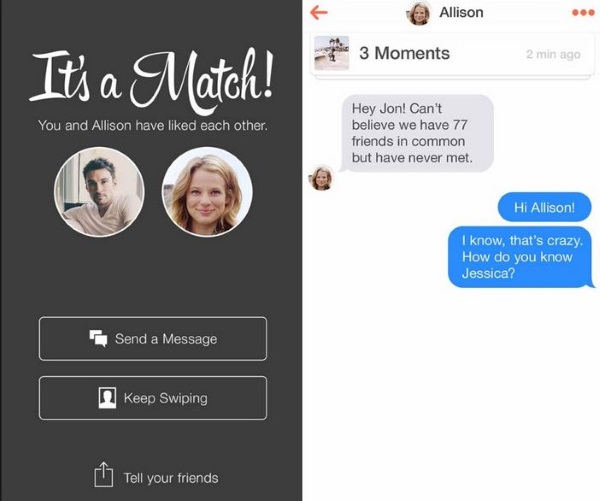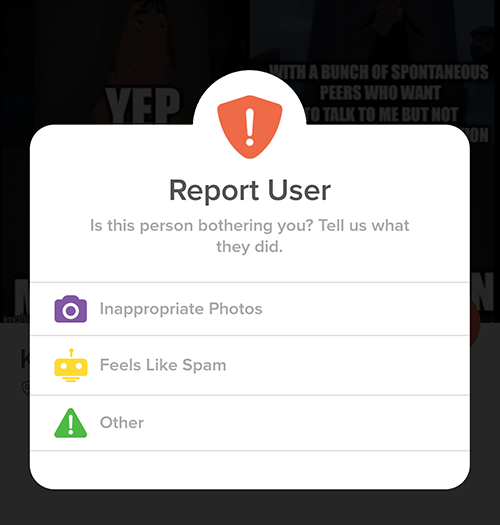How To Tell If a Tinder Profile is Fake (or a Bot)

Tinder is the most popular dating app in the world, with tens of millions of people using it to look for love. Tinder takes much of the stress and anxiety out of meeting new people by adding the matching and chatting process before any real-world dates take place. This gives people a chance to get to know one another without any serious consequences for failure. This encourages everybody to open up and explore whether they are compatible, in the safety and privacy of their own home, before deciding whether to meet up for real. The Tinder community overall is friendly and welcoming, and it’s relatively easy to meet new people and make real connections with them.
Being on Tinder can be a lot of fun, whether you’re looking to meet your next significant other, or just want to flirt and find a few potential dates or one-night flings. As you swipe through the app, sliding left and right to match with potential romantic partners, Tinder’s algorithm matches you with new people in your community and lets you browse their profiles. When you finally do make a match, you can start messaging with each other instantly, testing the waters and finding out whether you’re compatible.
There’s a big problem with this utopian vision of dating, though. Fake accounts (“catfish”) and bots are a major problem on Tinder, and seem to be getting worse with each passing month. In the world of online dating, it’s no secret that fake accounts and bots are everywhere. Fake accounts are accounts that are actually run by a person, but the picture(s) and information in the profile are all stolen or made up. Bots are computer programs designed to appear as human-like as possible, fooling you in conversation into clicking on spam or malware-filled links, giving up private information, or scamming you into paying money into a hacker’s bank account. Bots account for a huge percentage of traffic, though they aren’t all designed maliciously.
You’ve interacted with a bot before, even if you didn’t realize it – you may have talked to a customer service bot on the phone or online, dealt with a bot on a social network like Twitter, or replied to an automated service email in your inbox. That said, there are plenty of bots designed for evil purposes, and there are plenty of accounts like that on Tinder. Fake accounts, on the other hand, are driven by real human people, designed to fool you into thinking that the person is someone they’re not. You might have heard this described as “catfishing” in the past, after the popular documentary and television series of the same name. Catfishing can be harmful in more than one way: where a bot is often just after your information, catfishing can be damaging to your emotional health.

Although you would think that Tinder would try to weed out the bots and fakes, it seems like they do the minimum. Plenty of bots and fake users continue to get through whatever security screens they’ve set up. In part, this is understandable; any strong security screen is going to catch some legitimate users and deny them access to the app, and Tinder would rather get those customers and let everyone put up with some bot spam.
Both bots and fake accounts have the potential to cause harm. With some attention and watching for some telltale signs, you’ll be able to figure out exactly who is and isn’t a bot or a fake user. It’s actually fairly simple to identify both styles of malicious users once you know what to look for, and the purpose of this article is to teach you just that. Whether you’re looking for long-term love or short-term flings, you shouldn’t have to put up with fake accounts and computer programs cluttering up your Tinder feed.
Here’s our guide to looking for bots, fake accounts, and scammers, and how to protect yourself when you’re in the app.
What are Tinder Scammers Looking For?
One difficulty honest users have in detecting Tinder scammers is that there is no one common goal for scammers and spammers. However, there are a few basic categories of scammer on Tinder.

In general, bots and scammers are looking for a few different things from their victims:
- Financial gain: This can be as direct as literally taking money from your account, or as indirect as using your credit card or Social Security information to defraud you, opening accounts in your name and racking up charges,
- Malicious software or ads: If a user (or more likely, a bot) is sending you links online, it’s likely that they’re trying to get you to click on something to load advertisements and other unwanted content. At best, this is a way for these users to make a quick buck off people clicking on links with ads. At worst, these links can ask for your personal information, download content to your phone, and more. Since Tinder is a mobile-only app, you’re likely to avoid running into these sorts of issues, though it is possible that you could accidentally download dangerous APKs on an Android phone that has been rooted.
- Emotional damage: This one might sound strange, but some users who create fake accounts do it with the infliction of some sort of emotional damage as the goal. Often this is someone who has been hurt in relationships and decides to take “revenge” on the gender that they perceive as having wronged them. Others are more random, just wanting to hurt other people. Online harassment happens all the time to people who live their lives on the web. If someone is harassing you, unmatch them on Tinder (we’ll cover more of this below). The other side of emotional damage can come from those who are looking to gather dirt on someone, to coerce them into doing or saying something embarrassing or potentially damaging to their personhood or credibility. This doesn’t happen too often, but it essentially is a form of emotional blackmail, and it’s incredibly dangerous.
There are other things to watch out for on Tinder, but overall, most troublesome accounts online will fall into one of these three categories. By no means does the above mean you should avoid using Tinder, however. Financial dangers and malicious software are an everyday part of being a technology user in the 21st century, and while bullying and emotional damage are largely social and dating-based risks, the same kind of threat can occur on Facebook or Instagram. So instead of giving up on online dating altogether—or worse, giving up on the internet and moving to a log cabin—you should make sure you’re always vigilant about internet security while simultaneously keeping an eye out for the signs that someone is after your personal information or attempting to fool you.
Common Scams on Tinder
There are a number of common scams that bad actors attempt to execute on Tinder. Here are some of them.
The Verification Code Scam
This scam is easy to spot. The bot or catfish (it can be either one) chats with you for a bit, then tells you that “for their own safety” they want you to verify your Tinder account. This isn’t an impossible request; you can in fact verify your Tinder account if you are a celebrity or public figure by sending an email. However, ordinary Tinder users can’t verify their accounts, and even if they could this scammer doesn’t want you to do that. Instead, they give you a link that looks Tinder-related, but in fact takes you to their phishing site where they get your personal information, possibly even your credit card number. Luckily, the scam is obvious. Anyone asking you to verify your Tinder account is trying to scam you.
The Link Scam
Also easy to spot. The linker wants you to email them, or go to their cam page, or go to their personal web site. It doesn’t matter what they say; they just want you to click on their virus-laden malware link. Obviously, don’t do that. Nobody on Tinder for a legitimate reason is ever going to send you to a link. Ever.
The Blackmail Scam
This one is much trickier. The blackmailer is never a bot, it’s always a catfish, because they are trying to build a genuine rapport with you. They want you to trust them and to view them as a potential romantic partner. To that end, they will spend days talking with you and building a connection. Their goal, however, is not to have a relationship; it is to get you to do or say something incriminating. Their favorite target is married people who are on Tinder looking for something on the side, but anyone can be the subject of the scam; married people are just the easiest targets. They get compromising screenshots of the conversation, or solicit sexually explicit photographs, and then threaten to take those photos public or to contact the wife, husband, or partner of their victim with the screenshots unless they get paid.
There are a few different defenses to this scam. The obvious one is not to do or say anything incriminating on Tinder. Personally, I’m a single man with a very high tolerance for embarrassment; if some catfish wants to send my inappropriate selfies to Facebook, I could care less, and nobody is out there who would care if I’m trying to date online. Other people might have a different point of view. In general, do not send ANYTHING to a Tinder match that you wouldn’t post to your own Facebook page. Generally, the blackmailer is not going to be willing to meet in person, so if you’ve started seeing someone in the real world, you are less susceptible to this particular scam – but not immune.
The Venue Scam
This one is both clever and mean. The venue scammer is someone who has been hired to promote a bar, club, restaurant, or other public venues. They catfish dozens or hundreds of people at the same time and chat with all of them in a flirtatious and charming manner. Then, they ask for an in-person meeting! The victim of the scam is delighted, of course, and agrees to come to the XYZ Club at 9 pm on Tuesday, or whatever – only to discover when they arrive that there is an absolute crowd of people, all or many of whom were lured in by the scammer.
The Robbery Scam
The robbery scam takes things to a new level. It’s a variant of the venue scam – the catfisher charms the pants off of the victim and solicits a date. When the victim arrives at the scene, they find a gang of thugs instead of their partner, and they get robbed (if they’re lucky). This is relatively easy to defend against – don’t meet anywhere other than a public place with lots of people around. A warning sign will be someone who wants to meet with you after suspiciously little interaction and insists that it be at their hotel room or a dark parking lot somewhere.
The Long Con
Possibly the cleverest and most paranoia-inducing of all Tinder scammers. The “long con” is a term used by hustlers and con artists to describe a long-term operation against a particular person. The scammer is not trying to get anything from the victim right away, or even in the near future. Instead, they are collecting information and laying the groundwork for a much larger scheme. For example, a real person may build a relationship with you on Tinder for weeks or even months. They may go out on dates with you. They may actually have a relationship with you. More commonly, they just want to have a lot of meaningful deep conversations with you – conversations in which they find out a lot about you as a person. Things like where you went to school and what jobs you’ve had and where you’ve lived. All of this is part of a larger con aimed at getting access to your identity or your assets if you are a wealthy person. The best defense here is to be poor, but failing that, be very careful about who you let into your life.

Key Signs to Watch Out For
As we stated above, bots and fake accounts are two different things, and each has their own way of trying to fool you into giving up information on yourself. In general, bots are much easier to identify than fake accounts created and run by real humans. Because a bot can only respond with certain comments and scripted messages, most basic Tinder bots are easy to spot immediately – particularly once you’ve encountered a given bot already and can recognize its scripted dialog. (“Heyyy…”) Fake accounts are much harder since they will reply as real people, giving actual human answers to the questions you ask. Of course, both users typically give off some signs we can use to identify their accounts, and thanks to the tools built into Tinder, we can take responsibility into our own hands. Here’s a look at the key signs for both bots and fake accounts.
Bots
First things first: a standard Tinder bot isn’t exactly the smartest program in the world. Bots and AI components have reached new heights of ability, but the high-functioning bots are typically developed by large corporations with a lot of money to spend on pushing the envelope forward. For example, you’ll likely be hard-pressed to find a bot on Tinder that is anywhere as capable as Google’s Assistant platform or some of the Messenger bots developed by Facebook. In general, bots on Tinder were developed to automatically send a few messages, typically leading to dangerous URLs, and nothing more. These bots clearly manage to fool some users, but generally speaking, most internet-literate users have the capabilities to identify them. Still, here are some key tells when it comes to identifying these bots:

- Sexed-up photos on their account: There’s nothing wrong with showing a little skin on Tinder, and having a picture of you in a sweater next to a picture of you on a beach is totally acceptable. But if all or most of the photos on an account are nearly pornographic, there’s a good chance that the user isn’t a real person at all, but a stolen identity from Google Images and attached to a bot. Swipe left on these accounts.
- The accounts are almost always displaying female photos. Bots on Tinder generally target men, who are more likely to swipe right to a sexed-up account than women are to a sexed-up male account (same goes for men swiping right for sexed-up men and women swiping right for sexed-up women). A lot of bots will also only include a single photo since it’s much more difficult to fake multiple images on an account.
- Missing data in their profile: Before you swipe right, read over their profile. If their profile is suspicious in any way, swipe left. Broken grammar and poor spelling are a tell, but more likely, you’ll notice missing information or strange text that doesn’t quite make sense. Since bots often get banned from Tinder, their creators typically don’t put a lot of effort into the profile, copying and pasting again and again from a short form.
- Short conversations: If you do swipe right on an account that is run by a bot, you’ll likely immediately receive at least a single message. Sometimes multiple messages can come in at once, but smarter bots will wait for you to reply to the first greeting message before spamming you with the rest of their messages. Not only will these messages make little sense in the context of what you send to the user, but these messages will likely end after the scripted messages are sent, and your conversation will come to a close. And speaking of which…
- Leading to a URL: Though some bots may be designed to get you to reveal some sort of information, generally speaking, that’s a bit too complicated for an actual bot to manage to do. Since the bot can only reply with premade messages, naturally getting you to reveal some sort of information is more in the wheelhouse of a fake account. Typically, their messages lead to a URL that can be dangerous or misleading. The link sent in your messages is often preceded by messages promising photos of the “user,” or a link to their address in the area. Obviously, don’t click the link. Newer bots might also invite you to look at a social profile, on Instagram or Snapchat, or give you a phone number to contact. Again, you should avoid these users, especially if they fail the above tests.
Overall, 99 percent of the bots you encounter are going to make these same mistakes again and again. Technology just isn’t at the point where a single user can develop a nuanced, intelligent bot capable of recreating human speech patterns without a team of developers with a cash flow behind them, or dedicating hundreds of hours to creating the bot. It simply isn’t worth a bot developer to spam Tinder with that kind of technology when these bots are typically banned quickly, so looking for the above signs will let you know what you’re dealing with—and what to avoid.

Fake Accounts
Fake accounts, on the other hand, are much harder to spot without paying attention. While bots might be simplistic computer programs with faults and easy-to-spot tendencies, a real person pretending to be someone they aren’t is still going to seem like a real person, no matter what you do. Fake accounts run by real people can make up false information in their profile, stealing images from people they know in real life or find on Google Images (thanks to the ability to search for similar images, you can put together a profile with real images of people fairly quickly). These fake users can give real replies to your questions, complete with human emotion, emojis, correct spelling and grammar, and everything else that will convince you to believe it’s a real person. Catfishing has become such a major issue that plenty of people have been fooled. In addition to the documentary and the subsequent television show from which the term is derived, professional football player Manti Te’o received major coverage in and out of the world of sports in 2013 after it was revealed that the girlfriend he thought had died was actually a fake account, a person Te’o knew in real life who had fooled him into believing the person he met online was a long-distance girlfriend.
Acknowledging that these things happen is important, as is the process of approaching them with caution. If you think you may be dealing with a fake account, here are some signs that will help you identify whether you’re correct, and help you as you move through Tinder in the future:

- Missing or strange information in their bio: We already listed this for the bot section above, but this happens to be one of the few crossover elements you may actually notice between bots and fake accounts. Fake users have a habit of listing information that doesn’t quite seem to add up. While they may list a real bio, there’s just as good of a chance that something seems off about what they’ve published. If you read through their bio, but something seems fishy—say, they went to the same high school as you but you don’t recognize them, or they list something as a hobby but then ignore questions you ask about that hobby—report or unmatch the account and move on.
- Blank social profiles: You need to have a Facebook profile in order to use Tinder, no ifs, ands, or buts. But more importantly, Tinder allows you to insert some of your social network connections into the app to properly sync your content. Most importantly, you can sync photos from Instagram using the plugin, which displays your Instagram collection below your profile. It’s difficult to fake a full Instagram account, especially one that’s fully active, so looking for profiles that have an active social account added to the app may be a good idea. You can also look for Spotify in their profile, as a Spotify connection is another good sign the person is who they say they are.
- Lack of in-person contact: Unfortunately, sometimes you may be fooled into talking with someone for days across Tinder, only to slowly realize their actions have become strange. Is the person refusing to meet up with you in person, or won’t commit to a Skype or phone call? Those can be some serious signs that something isn’t right. If you’re concerned about this, make sure to ask your Tinder match for some kind of confirmation that they are who they say they are. This can be anything, though you should try to make sure that how you communicate is live. Invite them to a Facetime call, or push to set up your first coffee date. Whatever you do, make sure it’s in person or involves a live video feed of the person. If they refuse, stop communicating and contact Tinder.
- Google Image Search: It is shockingly easy to find photos of people online, especially when libraries of content are uploaded to social media each day. A fake account can be loaded with pictures of a single person while still remaining fake. If you’re concerned the person isn’t who they say they are, save one or more of their photos to your device and search for the image on Google Reverse Image Search. While you may find nothing, there’s also a chance you’ll come across a whole album of photos of the person that have been stolen online to create a faux-persona. Definitely bail on the account you’ve been matched with, and consider reporting the user.
Fake accounts are, without a doubt, harder to spot than their bot-brethren, but with a bit of patience and attention, you should be able to keep a close eye on your account and who you’re matched with, capable of looking at a name and photos and being able to discern whether or not the account is fake. As always, err on the side of caution with this: it’s better to miss out on a romantic match with someone who seems fake than to fall into the trap of chatting and giving up personal information with somebody malicious.
What to Do When You’ve Spotted a Fake Account
When you’ve spotted a fake account, or come across a bot, you may be considering what to do. While it might not be clear, the first, primary step is also the most obvious one: you should report and unmatch the account so that they can’t talk to you anymore. You don’t have to have matched an account to report them, though you can also report accounts you have been matched with as well. To report a potential bot or fraud account, go to their profile. Tap on the menu icon on your display (it will appear as an ellipse, a horizontal triple-dotted icon) and select Report. You’ll quickly be asked to fill out why you’re reporting the user, but overall, the process only lasts a few moments and is relatively easy to finish.
Note that if you plan to report AND unmatch, you need to report first – if you just unmatch, you won’t have any way of accessing the other account in order to report it.

The same goes for unmatching users. If you’re unsure whether the user contacting you is committing account fraud, you can still unmatch (and report) the user. Just as discussed above with the reporting method, tapping on the triple-dotted menu icon will load the option to unmatch an account. You aren’t necessarily limited to only unmatching or only reporting, so if you feel you’re in a situation that you need to do both, go right ahead. However, you should be careful when reporting. If you report too many accounts that aren’t actually bots or false users, you may find your ability to report users limited by Tinder. Blocking can be done as much as you feel comfortable doing.
One tip: if you are talking with a fake account, don’t get into an argument with them about them being fake. It may be very tempting to unleash all of your dating frustration on a basically anonymous source but it is not worth it. Some of the smarter scammers out there, confronted by an accusation of being fake, will immediately report YOUR account as being fake. Since they have dozens or hundreds of accounts, none of which they really care about, while you have only one account which you DO care about, playing “chicken” like this is not a good strategy for you. Just leave the conversation, report them to Tinder, and move on.
How to Avoid Fake Accounts
Obviously, knowing the key signs of a bot is important to identifying dangerous or fake accounts, but even if you’ve been fooled once or twice into buying into their story, you’ll want to take the steps to ignore accounts like this moving forward. Luckily for all Tinder users, by using the key signs we posted above, it’s actually pretty easy to identify these fake accounts, helping you to avoid them in general without accidentally matching with them first. Start by only choosing to swipe right on users that seem and feel real. Beyond the above steps, it’s typically important to trust your gut here. If something seems suspicious, just swipe left. If you’re worried about other users having to deal with a malicious account, report them as a false user. Don’t abuse the report system, but use it to your advantage if you feel unsafe.
***
No one is going to be able to avoid every scammer, bot, or fake account online, and Tinder is no exception. As with any online dating site, scammers are going to use the site to try to benefit their bottom line, earning them cash, personal data, or some kind of gratification along the way. This comes with the territory of participating in online communities in 2019, but thankfully, unmatching and reporting accounts on Tinder help to put an end to their “fun.” Tinder isn’t a place without harassment or dangerous users, but it is a place where you can feel safer than a bar or a club to meet people. Screen people effectively, always use caution, and generally be vigilant when it comes to looking at people that may not be who they say they are. Generally speaking, you’ll likely find that the majority of people you find on Tinder to be real humans (not that you don’t have to watch out for the humans as well), not bots or scammers. Still, being cautious is the best way to go, both on Tinder and the web in general, and with the reporting tools at your fingertips, you might as well lean into the support that exists on the platform in general.
Well, this was kind of a downer article, so how about some tips on how to do well with the actual people you’ll meet on Tinder?
A lot of us have trouble getting a conversation going – so check out our guide to some great ways to start talking on Tinder.
Want to get in touch with a live person at Tinder? It’s tricky – see our tutorial on calling someone at Tinder.
Did someone super-like you? Find out who!
Need a fresh start? Here’s how to reset your Tinder account.
If things didn’t work out, you might want to learn how to find out if someone unmatched you on Tinder.














7 thoughts on “How To Tell If a Tinder Profile is Fake (or a Bot)”